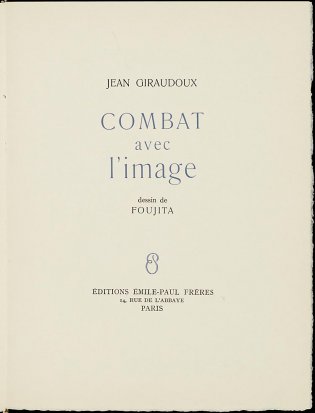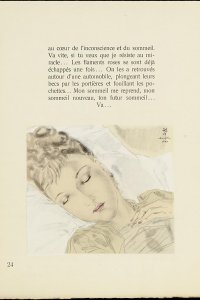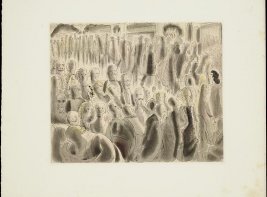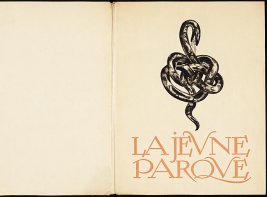Combat avec l'image
Year: 1941
Author: Jean Giraudoux (1882 - 1944)
Artist: Tsuguharu Foujita (1886 - 1968)
Publisher: Éditions Émile-Paul frères
Between Tokio and Paris
Tsuguharu Foujita was originally a Japanese artist, who was naturalised as a Frenchman in 1955, and who converted to Catholicism in 1959. He first visited Paris in 1913, since then dividing his time between Tokyo and Paris whenever he wasn't on one of his many international travels. He was successful in Japan at an early age. The emperor purchased one of his works, and he was commissioned to paint a portrait of the Korean emperor. In Paris he became one of the most striking figures in Montparnasse. His work followed a new direction. He produced mostly murals and aquarelles in a style related to naïve painting, Expressionism and Japanese decorative painting. After the terrors of World War I and the advent of Cubism he felt the time had come for a return to the traditional art of painting. His work is characterised by his calligraphic lines, for which he used the thinnest brushes, and his milky-white surfaces, for which he used special ingredients, such as finely ground oyster shells.
Foujita drew flowers, cats, and especially young ladies with closed eyes, as in the portrait he produced for this edition. In the text it is referred to as a dry-point etching, while the colouring could be in watercolour. Combat avec l'image was reproduced through lithographic means. The milky-white area in this illustration was the last to be printed. The drawings were first printed in colour as a kind of background for the text; the text was then printed, and finally the milky-white was printed over the illustration and the text. The text therefore isn't consistently black, but grey and even bluish, and the graphic unity between text and illustration is maximized. This is all the more striking in the 100 copies that were not printed on white paper, but on chamois-coloured BFK de Rives. According to Giraudoux's biographer, Foujita's original portrait was stolen around 1990.
Bibliographical description
Description: Combat avec l'image / Jean Giraudoux ; dess. de Foujita. - Paris : Éditions Émile-Paul frères, 1941. - [24] p. : ill. ; 26 cm
Printer: l'Imprimerie Aranéenne
Edition: 1100 copies
This copy: Number 56 of 100 on BFK de Rives
Bibliography: Bénézit 5-603 ; In liefde verzameld 40 ; Monod 5442
Shelfmark: KW Koopm A 744
References
- Jacques Body, Giraudoux et l'Allemagne. Paris, Didier, 1975
- Paul van Capelleveen, Sophie Ham, Jordy Joubij, Voices and visions. The Koopman Collection and the Art of the French Book. The Hague, Koninklijke Bibliotheek, National Library of the Netherlands; Zwolle, Waanders, 2009
- Paul van Capelleveen, Sophie Ham, Jordy Joubij, Voix et visions. La Collection Koopman et l'Art du Livre français. La Haye, Koninklijke Bibliotheek, Bibliothèque nationale des Pays-Bas; Zwolle, Waanders, 2009
- Philippe Dufay, Jean Giraudoux: Biographie. Paris, Julliard, 1993
- Jean Giraudoux, Oeuvres romanesques complètes.Paris, Gallimard, 1990-1993. (Bibliothèque de la Pléiade)
- Bettina Liebowitz Knapp, 'Jouvet and Giraudoux 1928-1934', in: Louis Jouvet, man of the theatre. New York, Columbia University Press, 1957
- Maurice Martin du Gard, Les mémorables, 1918-1945. Paris, Gallimard, 1999
- Paul Morand, Foujita. Paris, Chroniques du jour, 1928








